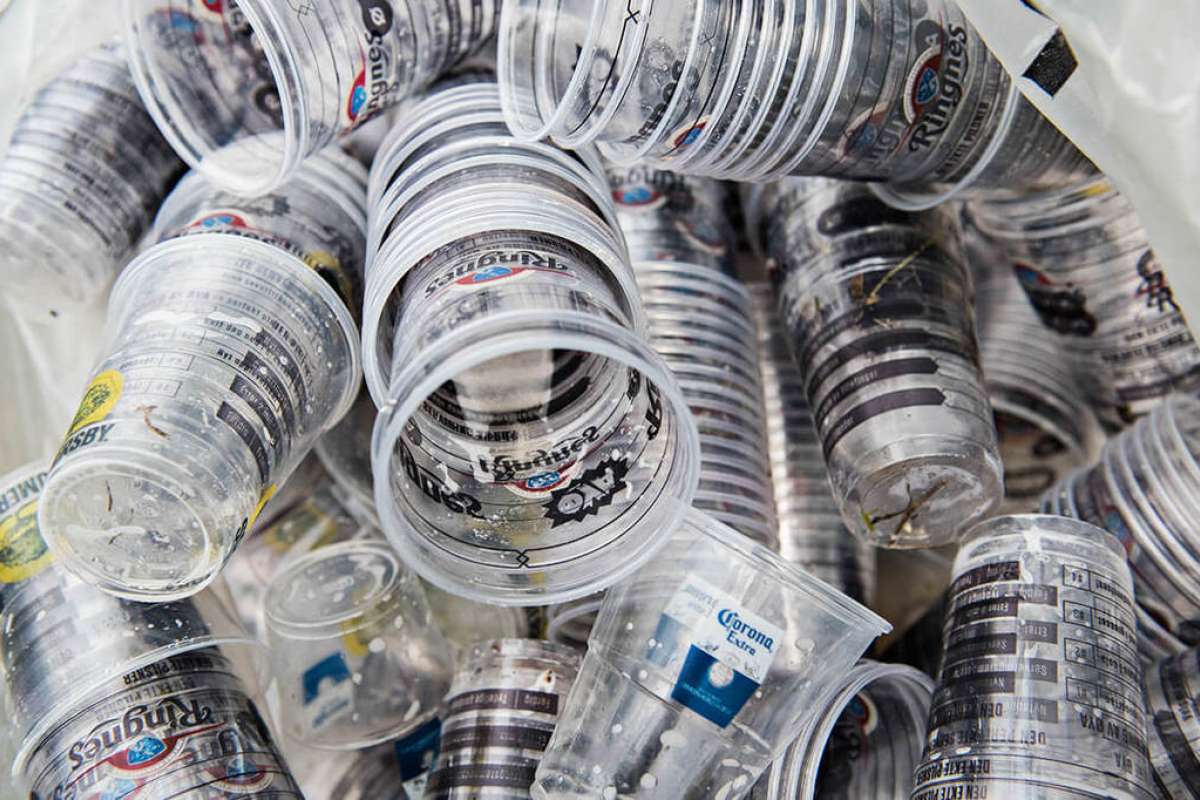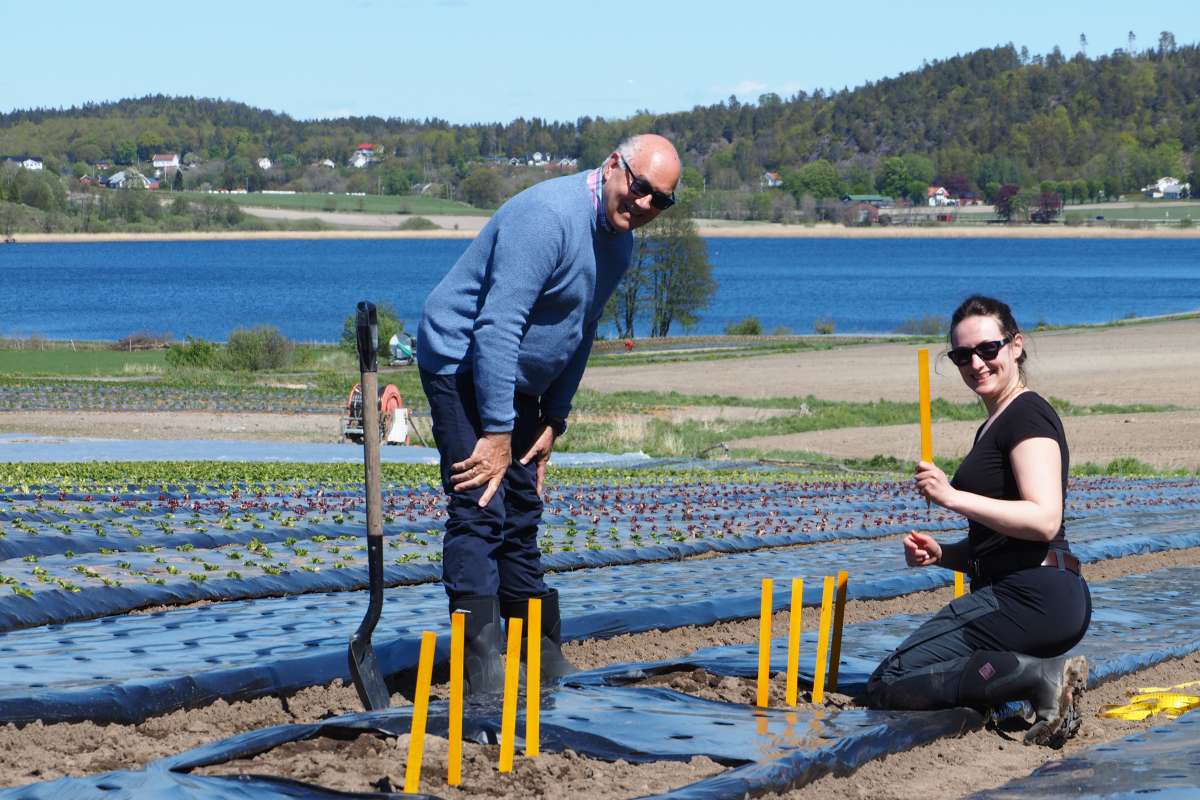Degradation in waste streams (WP3)
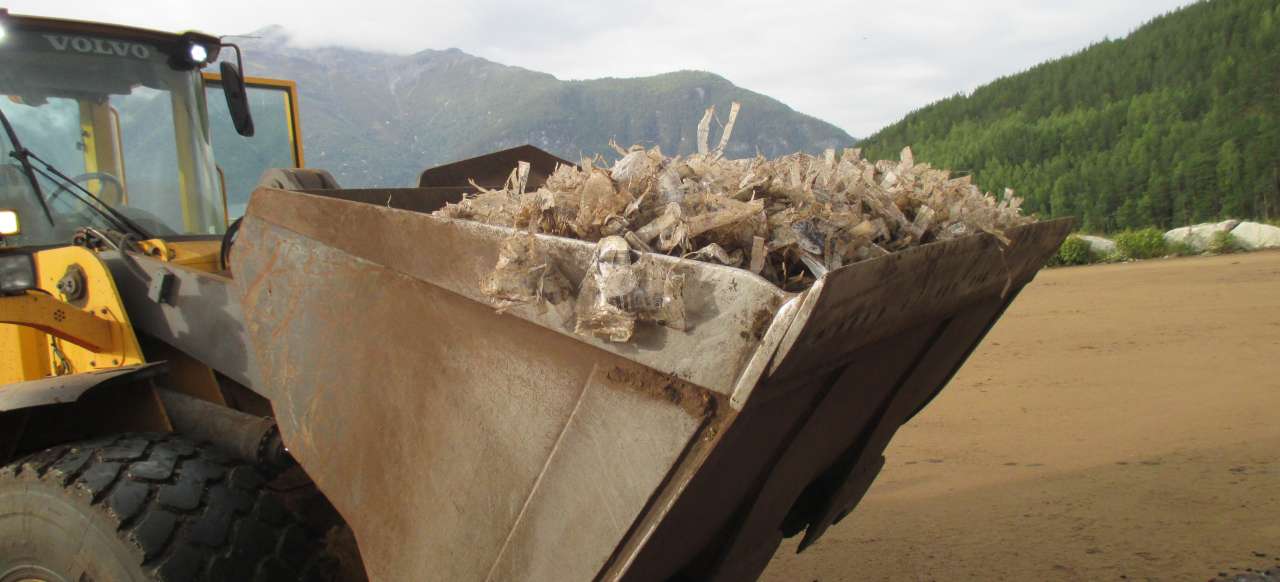
Compostable PLA beer glasses ready to be composted at SIMAS, Norway. Photo: SIMAS
Some biodegradable products, such as waste bags, cutlery and drinking cups, are marked as compostable. How fast do they degrade during composting? Can composting and anaerobic digestion (biogas production, much more common in Norway than composting) be a source of plastics in the environment?
Here are two common logos for compostable plastics:

We have selected several biodegradable plastic products, marked as compostable, and followed their degradation during composting. Composting is an intricate process, as shown on the figure below. It consists in a series of degradation processes occuring in presence of oxygen.
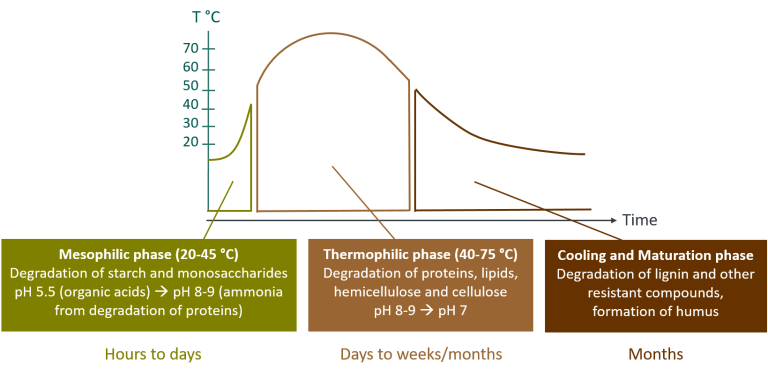
In addition to composting experiments in 135 L compost tumblers at NIBIO, we have conducted large scale experiments at SIMAS, one of the very few composting plants in Norway that receive and compost compostable plastic waste.
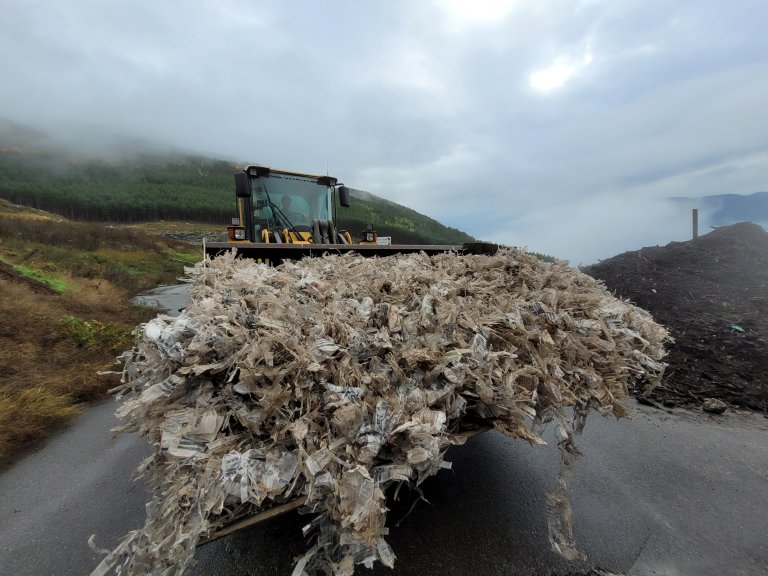
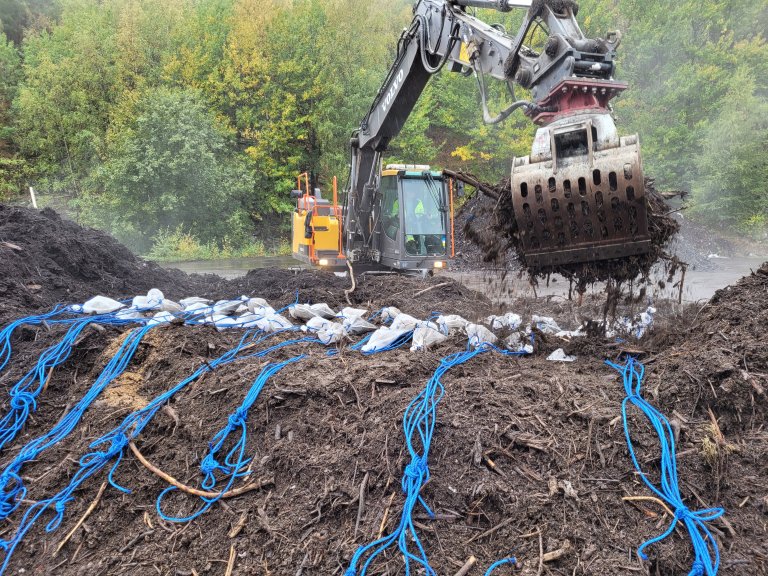
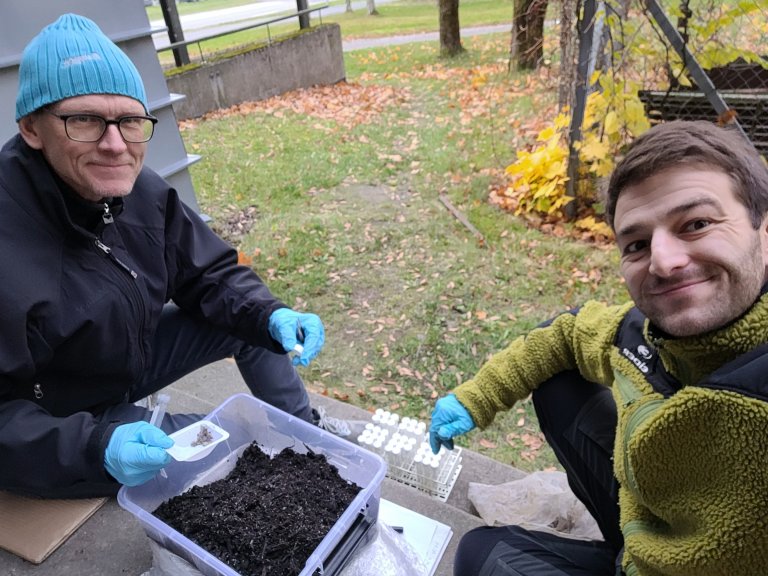
Conclusion: The PLA glasses, ending up where they were meant to end up - in a properly managed industrial composting plant - were degraded within 3 months.
We also studied the fate of biodegradable (compostable) plastic bags during anaerobic digestion (biogas production), in a sister project "MOBIPLAST", funded by the Norwegian Retailers' Environment Fund (Grant 12414). Here we showed the compostable plastic bags used for food waste collection do not degrade much during anaerobic digestion.
Contacts



Contacts



Publications
Abstract
No abstract has been registered
Authors
Claire CoutrisAbstract
No abstract has been registered
Abstract
De siste årene har det kommet en rekke bionedbrytbare plastvarianter, også i Norge. Men hvor nedbrytbar er egentlig denne plasten under norske forhold med relativt lave temperaturer? Brytes den fullstendig ned, eller omdannes den til makro- eller mikroplast i stedet? Gjennom prosjektet DGRADE – Nedbrytning av bionedbrytbar plast i jord og avfallsstrømmer har forskere forsøkt å finne svar på disse spørsmålene. De kan nå slå fast at plasten brytes ned, men kun hvis forholdene ligger til rette for det. Hvis ikke forholdene er gode nok, kan også nedbrytbare plastprodukter bidra til plastforsøpling
Abstract
Ny forskning viser at nedbrytbar plast brytes ned under norske forhold, men kun dersom den havner der den skal. Det vil si i industriell kompost eller i et jordmiljø der forholdene ligger til rette for at mikroorganismene kan bryte den ned.
Authors
Claire CoutrisAbstract
No abstract has been registered
Authors
Claire CoutrisAbstract
Søkelyset på utfordringene med plast og forsøplingsproblematikken har sammen med nye krav og forbud fra EU, ført til at mange produsenter ønsker seg gode alternativer til fossil plast. Et resultat av dette er at stadig flere velger bionedbrytbar plast i emballasje eller som alternativ i landbruket. Men hva skjer med den bionedbrytbare plasten? Enten ute på jordet eller i kommunale biokomposteringsanlegg. Blir den brutt ned? Det er noe Grønt Punkt Norge ønsker bedre svar på. Derfor har vi vært initiativtaker til et 3-årig prosjekt hvor NIBIO skal forske på dette. Prosjektet er nå halvveis og onsdag 24. mars vil forsker Claire Coutris fra NIBIO dele noen foreløpige resultater.
Authors
Claire CoutrisAbstract
No abstract has been registered
Authors
Claire CoutrisAbstract
No abstract has been registered
Abstract
There is an increasing interest in plastics, both as a resource and as a pollutant. In Europe, 25.8 million tons of plastic waste are generated each year, and their effects on climate, economy, human and environmental health are major challenges that society needs to address. Although a lot of emphasis is placed on recycling, the use of recycled plastics is still low in the EU. In this context, climate change and environmental concerns have boosted the development of various types of biodegradable plastics. The use of biodegradable plastics spans from disposable containers for food/drink, serviceware and wipes, via waste bags for organic waste collected for biogas production, to agricultural films used to cover soil during vegetable production. However, biodegradable plastics are rarely degraded so quickly and completely that the products disappear in nature, and the label may encourage people think otherwise, enhancing littering. The aim of our study was to describe the fate of biodegradable materials and products during waste treatment, and more specifically during composting. How long does it take these materials to degrade? What are the conditions for degradation, and ultimately, for obtaining plastic-free compost products? To answer these questions, we selected relevant materials, including compostable serviceware, biodegradable plastic bags used for organic waste collection, and biodegradable agricultural mulch films. Composting experiments were performed both at lab-scale (1.5 L containers with externally applied heating) and larger scale (in 140 L insulated compost tumblers, with natural heating from the composting processes, continuously monitored). The endpoints studied were recovery, mass loss, changes in morphology and composition, and microbial analysis of the various composts. In addition, we assessed the applicability of chemical digestion methods used for sample pretreatment of environmental samples containing conventional plastics to biodegradable plastics. Biodegradable plastics is an umbrella term covering materials with diverse polymeric compositions and thus material properties. This was well demonstrated by our selected materials, which displayed distinct degradation behaviors under similar controlled conditions. The time-course of degradation during composting will be presented for all selected materials, together with the main parameters influencing their degradation rates. In addition, some methodological challenges in this research field will be discussed. Finally, experience from a municipal composting facility receiving biodegradable plastic waste will also be presented to put our laboratory-based results into perspective.
Abstract
Stadig flere bønder bytter ut tradisjonell landbruksplast med bionedbrytbar plastfilm som kan freses rett ned i jorda etter bruk. Nå er forskere i gang med å undersøke hvor nedbrytbar den faktisk er under norske forhold.
Abstract
Stadig flere bønder bytter ut tradisjonell landbruksplast med bionedbrytbar plastfilm som kan freses rett ned i jorda etter bruk. Nå er forskere i gang med å undersøke hvor nedbrytbar den faktisk er under norske forhold.
Abstract
No abstract has been registered
Abstract
No abstract has been registered
Authors
Andreas BrilkeAbstract
Plastics in terrestrial ecosystems negatively affect their functioning by altering physical properties and disturbing soil microorganisms. The same could be true for biodegradable plastics entering nature through incomplete degradation in composting plants, and their subsequent application to soil in fertilizer substrate. So far, no standard analysis protocol for biodegradable plastic degradation exist. This Master's thesis has focused on developing methods for the analysis of biodegradable plastic degradation in a compost matrix and lays a foundation which later research can be built upon. Fenton's reagent and hydrogen peroxide were tested as a sample up-concentrating pre-treatment of an organic matter matrix containing biodegradable microplastics. The degradation of four different biodegradable plastics in nylon bags in a compost tumbler and a compost oven incubation were assessed. Samples for pH and phospholipid fatty acids (PLFA) of different treatments were collected to compare their development and interchangeability. Fenton's reagent was the better suited up-concentrating pre-treatment for samples with some uncertainty remaining. Assessing the biodegradable plastic degradation indicated an incomplete process in home composts and (Norwegian) composting plants. pH values coarsely reflected the composting conditions and suggested interchangeability of most treatments. Analysis of pH together with PLFA results would have been optimal, but could not be accomplished as the COVID-19 epidemic hindered the PLFA analysis. While some uncertainties in the developed methods remain, it can be concluded that a basis for establishing biodegradable plastic degradation analysis was created. Subsequent research should continue their development to assess whether biodegradable plastic remains from composting plants contribute to the accumulation of plastics in terrestrial ecosystems.
Authors
Erik J. JonerAbstract
No abstract has been registered
Conference lecture – Plast og mikroplast i jord: hvilke utfordringer står vi overfor?
Claire Coutris
Authors
Claire CoutrisAbstract
No abstract has been registered
Abstract
Vi har alle hørt om problemene plast i havet kan føre med seg. Men plast havner også i jord, blant annet via avløpsslam, biogjødsel og fra plastbruk i landbruket. Akkurat hvor mye plast det er snakk om er imidlertid uvisst.
Abstract
Vi har alle hørt om problemene plast i havet kan føre med seg. Men plast havner også i jord, blant annet via avløpsslam, biogjødsel og fra plastbruk i landbruket. Akkurat hvor mye plast det er snakk om, er imidlertid uvisst.
Abstract
Vi har alle hørt om problemene plast i havet kan føre med seg. Men plast havner også i jord, blant annet via avløpsslam, biogjødsel og fra plastbruk i landbruket. Akkurat hvor mye plast det er snakk om, er imidlertid uvisst.
Authors
Erik J. JonerAbstract
No abstract has been registered

